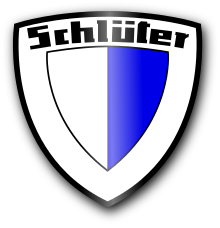Anton Schlueter (Company)
Anton Schlueter Munich was a German manufacturer of tractors and stationary engines .
Beginnings
The company was founded in 1898 by Kommerzienrat Anton Schlüter to build gasoline and multi-fuel engines . Twelve years later, Schlüter acquired the Otto Schülein machine factory in Freising and subsequently converted it into a foundry. In built on Schlüter before Freising an agricultural engineering research center, released today by the dairy Weihenstephan used Schlütergut . During the First World War, the architects Jakob Heilmann and Max Littmann built a third plant. This was created in the south of Freising near the Schlütergut.
Tractor construction
Schlueter began building tractors in 1937. In 1939, the first tractor tops were developed together with Fritzmeier . Due to the war-related shortage of petrol, wood gas tractors and wood gas electric units with 25 and 50 hp were also produced from 1942 onwards . Both the Munich plant and the foundry in Freising were largely destroyed by the bombing raids on Munich and Freising.
Based on the wood gasifier tractor, the Schlüter DSU with a diesel engine was offered in 1947/48 . When Anton Schlueter junior took over the management of Schlueterwerke in 1949 after the death of his father, he decided not to rebuild the plant in Munich and the foundry, but to concentrate production on one plant. From 1962 the Schlüter tractors came with a body designed by Louis Lucien Lepoix . Schlüter has specialized in the construction of large tractors since 1964. These included the Super (up to 280 hp), Super Trac with four wheels of the same size (up to 300 hp) and Profi Trac with four wheels of the same size (up to 320 hp as standard). The series of smaller models was called "Compact".
In 1978 the most powerful tractor in Europe, the Profi Trac 5000 TVL with 368 kW (500 PS), was built as a unique specimen . The construction contract came from the Yugoslav head of state Josip Broz Tito . Plans for the series production of the 5000 TVL became obsolete with the political changes in Yugoslavia after 1990. In 1989, the Euro Trac was introduced as a new series with up to 200 HP and movable ballast weight. However, the competition had long since overtaken Schlüter technically, and after the fall of the Wall in 1989 , more powerful standard tractors were more in demand than system tractors . Only 184 copies of the Euro Trac were built before Schlüter had to file for bankruptcy.
In addition, the plant in Freising had to be closed for legal reasons and it was planned to build a new plant in the immediate vicinity. Anton Schlüter also saw the opportunity to bring the products from Landtechnik Schönebeck to Freising in order to complete their own range in the lower performance class with their Systra system tugs. This did not come about on the one hand because of the veto of the trust company, which was supposed to bring companies from the old federal states to the new ones, on the other hand because of the advanced age of the company boss Anton Schlueter.
The decision was therefore made to relocate production and the spare parts warehouse to Schönebeck. With a few exceptions, none of the Freising workforce was taken on, but a social plan for the former employees was financed through the sale of the factory premises and the Schlütergut.
Shutdown
When the factory in Freising closed in December 1993, production of the Euro Trac and, in a few cases, the Super Trac was relocated to agricultural machinery Schönebeck AG (at the time of the Euro-Trac production, "Landtechnik Schlüter") in Schönebeck in Saxony-Anhalt . There production had to be stopped after only 32 copies were produced. The Egelseer company in Fürth bought the remaining spare parts, but also complete partial sets for Schlüter tractors from LTS. Until 2005, a few Eurotrac system tractors and a few standard tractors of the Super and Compact types were built.
Egelseer originally planned to re-enter the new tractor market with a completely revised super standard tractor series and the Eurotracs. However, there were around 20 tugs built on request.
The closed plant in Freising stood for more than a decade as an industrial ruin with the two distinctive towers at the entrance to the town (Staatsstrasse 2350 from Munich). The remaining parts of the building are recognized and protected as a cultural monument. By the end of 2009 the halls were renovated and converted into a shopping center. There was also space for a restored Schlüter tug, which is a reminder of the earlier use of the halls.
Anton Schlüter died in the summer of 1999. Numerous fan clubs cultivate the memory of the Bavarian tractor brand and regularly organize Schlüter field days, which no longer reach the number of visitors of the original "Schlüter days", in which up to 30,000 people took part.
literature
- Wolfram A. Riedel: Schlüter tractors as strong as a bear. DLG-Verlags-GmbH, 1998, ISBN 3-7690-0561-9 .
- Karl-Heinz Fischer, Klaus Tietgens: Schlueter around the world - two bears on the move. DLG-Verlags-GmbH, 2004, ISBN 3-7690-0619-4 .
- Klaus Tietgens: Schlüter tractors in action. Verlag Podszun-Motorbücher GmbH, 2005, ISBN 3-86133-380-5 .
- Klaus Tietgens: All Schlueter tractors. Verlag Klaus Rabe, ISBN 3-926071-21-4 .
Web links
- Timeline
- http://www.schlueter-fanpage.de/
- http://www.schlueterfreunde.de/
- http://www.schlueterhallen-freising.de
- http://www.schlueterclub.de/
Individual evidence
- ↑ Reinhard Kögler: SCHLÜTER oldtimer stationary engines . Retrieved May 10, 2015.
- ↑ Professional magazine for agricultural technology: What actually became of the Fritzmeier covers , Issue 9, 2014, p. 129





